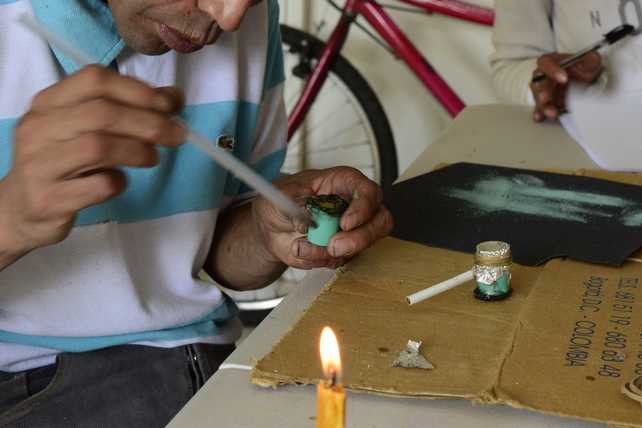|
Find out more, as we attempt to debunk the four most common myths about the smokable cocaine market in this newsletter
4 common myths about the smokable cocaine market
From 2014 to 2018, our research partners in Latin American and Caribbean cities gathered information from people who use or sell smokable cocaine, in order to identify key patterns in the regional markets of smokable cocaine. The information and testimonials we gathered reveal a lack of policy responses beyond punitive measures. Meanwhile, myths and misunderstandings about smokable cocaine and its users prevail. Read on below as we attempt to debunk the four most common myths.
 Photo credit Levinson Niño (Colombia)
Myth #1: Smokeable cocaine is the same thing as ‘crack’
There is much confusion about what the term ‘smokable cocaine’ refers to. Generally speaking, what is smoked can be divided into two main categories of substances:
1) Cocaine base paste (CBP) is the intermediate product in the extraction process from coca leaves to the final product (cocaine hydrochloride). CBP comes in many shapes and forms and has different names (such as paco, basuco, or pitillo). It is most commonly found in coca growing and processing areas, but not exclusively any more.
2) Free-base cocaine or crack, is produced through a reconversion of cocaine hydrochloride (powder) into a base-cocaine. Different chemicals and cooking procedures may be used to convert it into a smokable form.
In short, the term ‘smokable cocaine’ refers to several substances whose production and consumption are influenced by cultural, socioeconomic, and (geo)political factors, although their physical effects are nearly identical. ‘Crack’ is only one of these varied substances, though probably the most common.
Myth #2: There are no harm reduction measures for smokable cocaine use
Most of the negative consequences related to the use of crack, basuco or coca paste are associated with their method of administration, and the social context in which this occurs, rather than the short-term pharmacological effect of the drug itself. However, there is a relationship between the very short lived effect and the sharp decline felt by users afterwards, which makes its use hard to control.
Despite facing severe socioeconomic exclusion, smokable cocaine users are already practising harm reduction and using self-regulation strategies, for example by using safer smoking kits, or by recalling the principle of ‘bed, bread, and bath’. Nevertheless, the majority of users living on the streets remain neglected, and suffer high degrees of criminalisation and stigmatisation. In addressing this gap, São Paulo’s Braços Abertos harm reduction and socioeconomic welfare programme serves as an important model for the region.
 Photo credit Eduardo Zafra (Mexico)
Myth #3: Using smokable cocaine increases one’s likelihood of becoming homeless
One of the most common and disturbing myths about smokable cocaine is that its consumption often results in homelessness. While it is true that many users are homeless, it is crucial to note that their homelessness – along with vulnerability and lack of education, as highlighted by one of our researchers in Argentina – generally predates consumption. As one of our researchers in Brazil put it, ‘people who live on the street are not on the street because they smoke crack, but get acquainted with crack once there.’
In fact, many people who consume smokable cocaine started their consumption in order to cope with harsh living conditions - with little or no access to public health and other essential services - and/or other traumatic experiences.
 Photo credit Levinson Niño (Colombia)
Myth #4: The smokable cocaine market is a recent phenomenon
The smokable cocaine market was established decades ago, and is definitely not a new phenomenon. Rather than disappearing, it is undergoing a slow expansion: from a rather localised and isolated habit in the Andean region in the 1970s, it has become a phenomenon throughout North and South-America, including the Caribbean and Central American regions and Europe.
In many places there is a clear disparity in both sentencing levels and the number of arrests for powder cocaine and crack cocaine, with the latter being much more heavily penalised.
Hungry for more?
|